Abstract
Phagocytic function was assessed by serial whole blood chemiluminescence in poorly controlled type 2 (non-insulin dependent) diabetic patients during efforts to improve glycaemic control and compared with a group of well controlled type 1 (insulin dependent) diabetic patients. Chemiluminescence (corrected to a standard polymorphonuclear count) remained below normal (0.15-0.30 photons/second/cell) for most of the type 2 patients until 12 weeks when the value was significantly increased in patients showing improved glycaemic control (mean (range) 0.25 (0.01-0.43) photons/second/cell) compared with those showing no improvement (0.12(0.01-0.31) photons/second/cell). There was a significant inverse correlation of delta HbA1 with delta chemiluminescence. Although mean chemiluminescence for the type 1 diabetic patients was within the normal range, there was a wide scatter of values (0.19 (0.04-0.43) photons/second/cell) and there was no significant difference compared with the final value of type 2 patients with improved control. Glycaemic control is therefore a major determinant of phagocytic function in diabetic patients, but other factors must contribute, particularly in type 1 (insulin dependent) patients.
Full text
PDF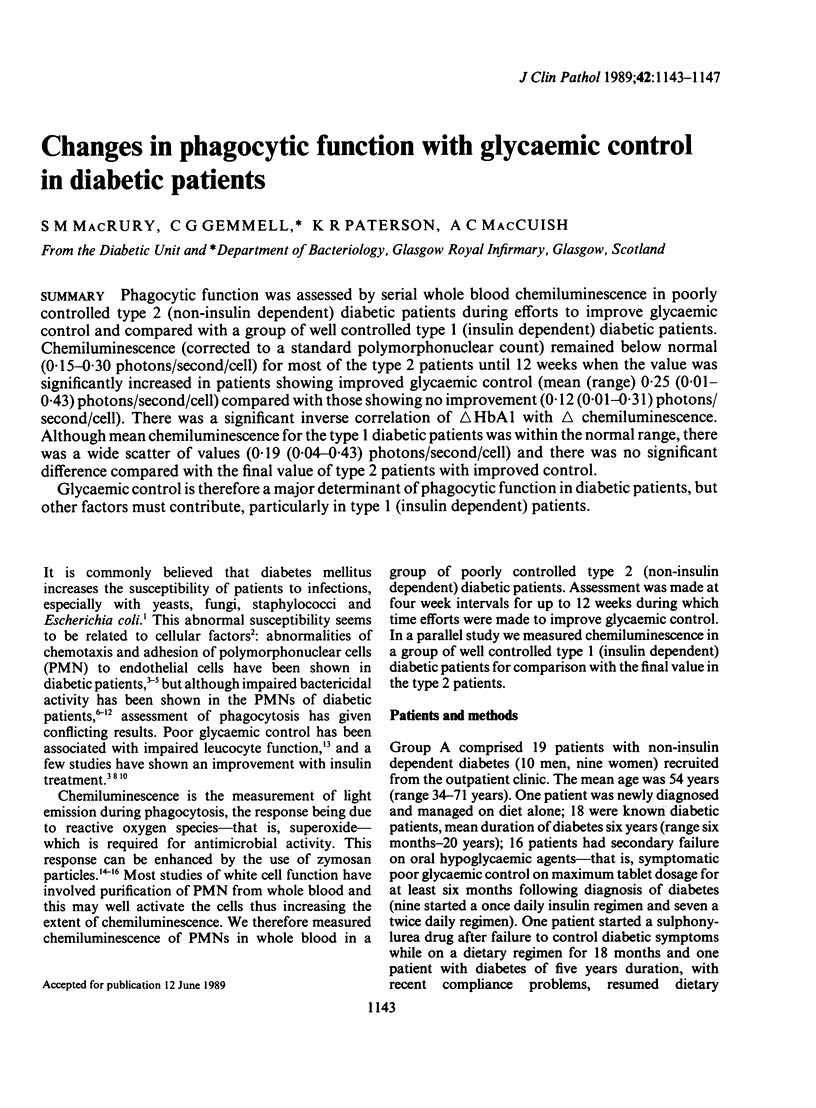
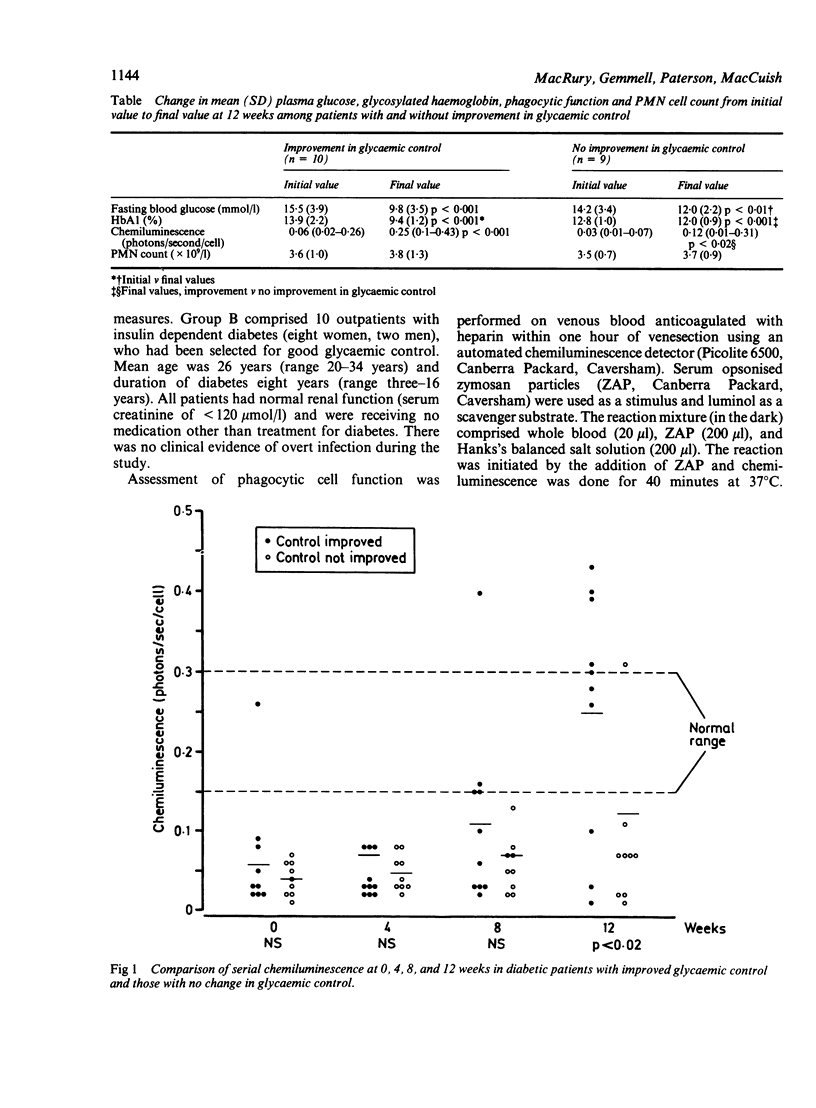
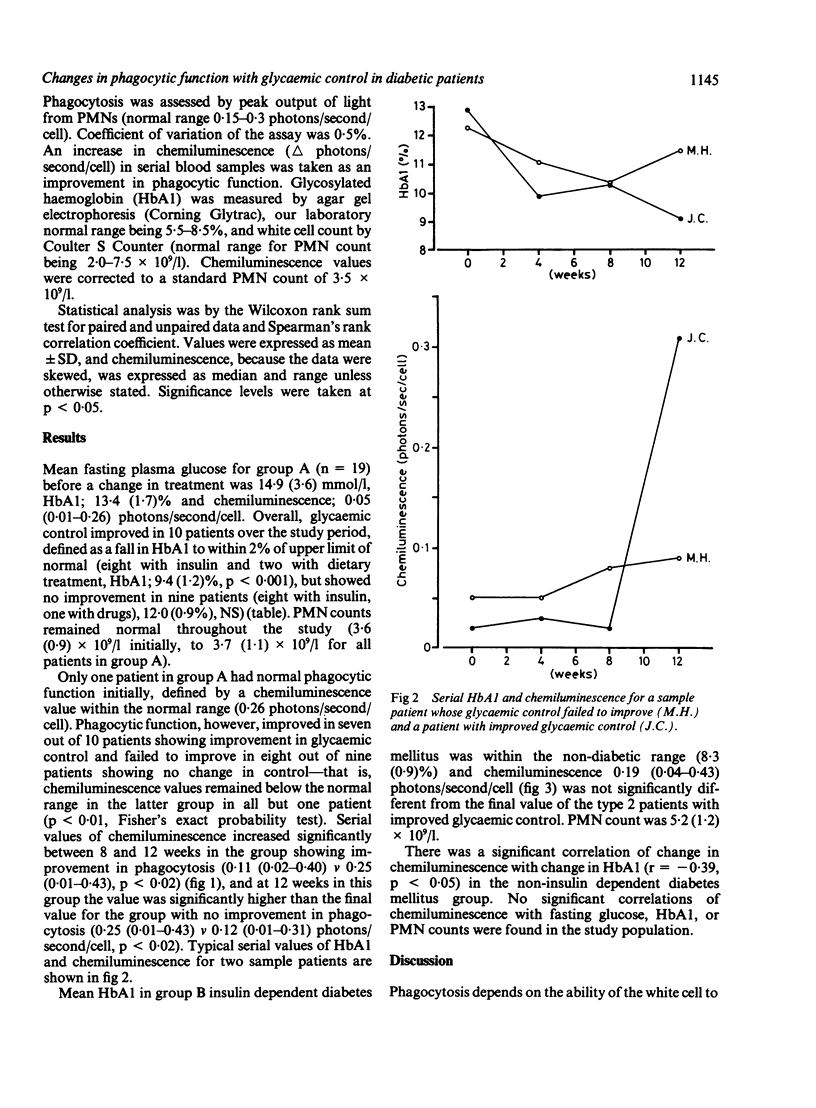
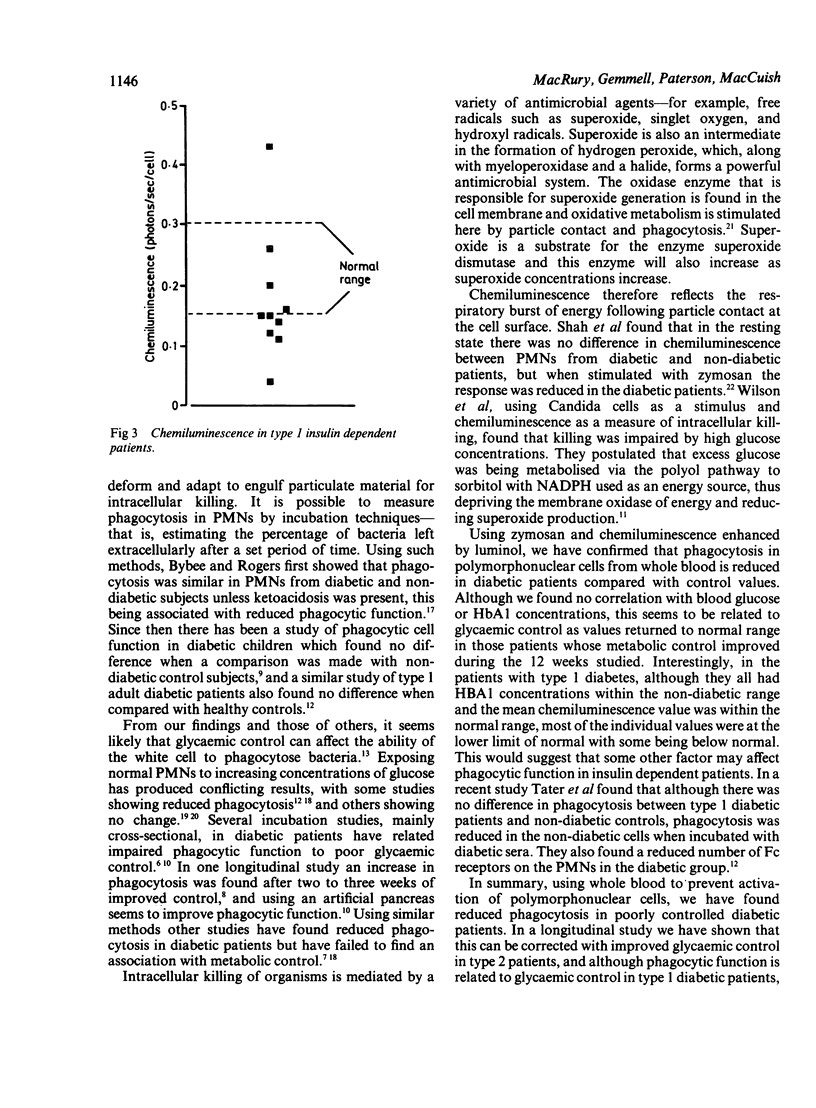
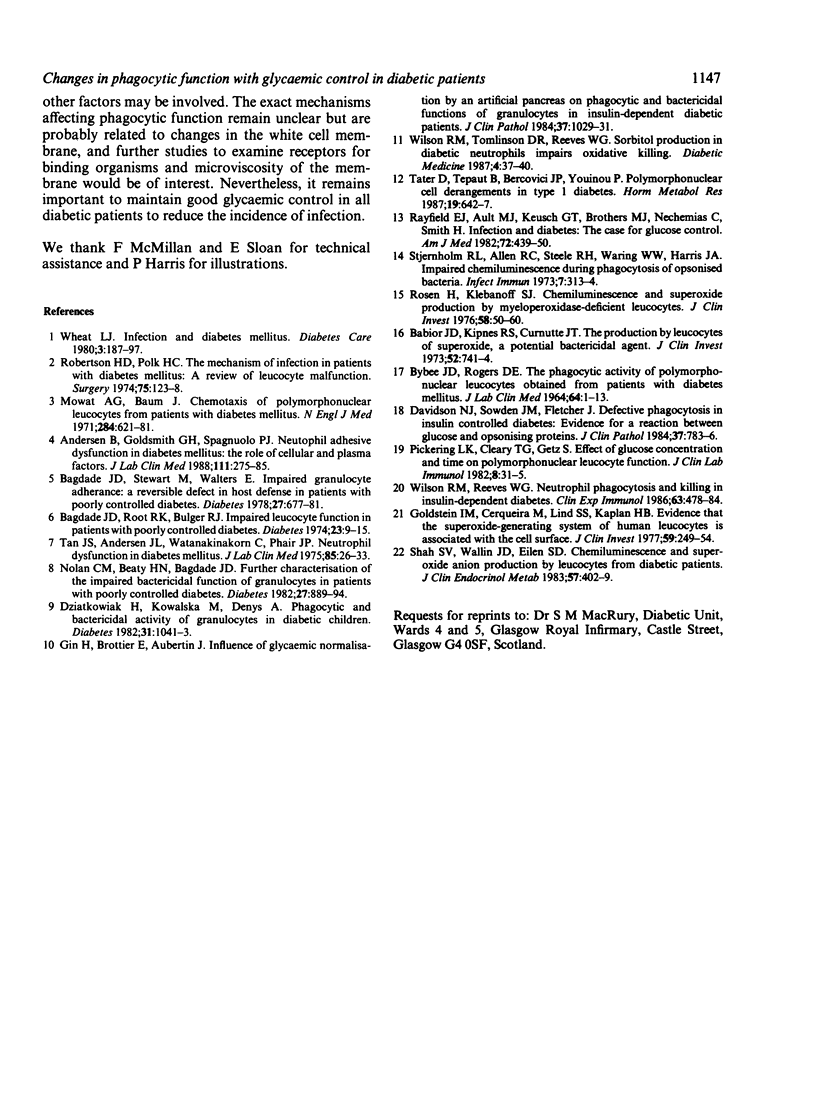
Selected References
These references are in PubMed. This may not be the complete list of references from this article.
- Andersen B., Goldsmith G. H., Spagnuolo P. J. Neutrophil adhesive dysfunction in diabetes mellitus; the role of cellular and plasma factors. J Lab Clin Med. 1988 Mar;111(3):275–285. [PubMed] [Google Scholar]
- BYBEE J. D., ROGERS D. E. THE PHAGOCYTIC ACTIVITY OF POLYMORPHONUCLEAR LEUKOCYTES OBTAINED FROM PATIENTS WITH DIABETES MELLITUS. J Lab Clin Med. 1964 Jul;64:1–13. [PubMed] [Google Scholar]
- Babior B. M., Kipnes R. S., Curnutte J. T. Biological defense mechanisms. The production by leukocytes of superoxide, a potential bactericidal agent. J Clin Invest. 1973 Mar;52(3):741–744. doi: 10.1172/JCI107236. [DOI] [PMC free article] [PubMed] [Google Scholar]
- Bagdade J. D., Root R. K., Bulger R. J. Impaired leukocyte function in patients with poorly controlled diabetes. Diabetes. 1974 Jan;23(1):9–15. doi: 10.2337/diab.23.1.9. [DOI] [PubMed] [Google Scholar]
- Bagdade J. D., Stewart M., Walters E. Impaired granulocyte adherence. A reversible defect in host defense in patients with poorly controlled diabetes. Diabetes. 1978 Jun;27(6):677–681. doi: 10.2337/diab.27.6.677. [DOI] [PubMed] [Google Scholar]
- Davidson N. J., Sowden J. M., Fletcher J. Defective phagocytosis in insulin controlled diabetics: evidence for a reaction between glucose and opsonising proteins. J Clin Pathol. 1984 Jul;37(7):783–786. doi: 10.1136/jcp.37.7.783. [DOI] [PMC free article] [PubMed] [Google Scholar]
- Dziatkowiak H., Kowalska M., Denys A. Phagocytic and bactericidal activity of granulocytes in diabetic children. Diabetes. 1982 Dec;31(12):1041–1043. doi: 10.2337/diacare.31.12.1041. [DOI] [PubMed] [Google Scholar]
- Gin H., Brottier E., Aubertin J. Influence of glycaemic normalisation by an artificial pancreas on phagocytic and bactericidal functions of granulocytes in insulin dependent diabetic patients. J Clin Pathol. 1984 Sep;37(9):1029–1031. doi: 10.1136/jcp.37.9.1029. [DOI] [PMC free article] [PubMed] [Google Scholar]
- Goldstein I. M., Cerqueira M., Lind S., Kaplan H. B. Evidence that the superoxide-generating system of human leukocytes is associated with the cell surface. J Clin Invest. 1977 Feb;59(2):249–254. doi: 10.1172/JCI108635. [DOI] [PMC free article] [PubMed] [Google Scholar]
- Mowat A., Baum J. Chemotaxis of polymorphonuclear leukocytes from patients with diabetes mellitus. N Engl J Med. 1971 Mar 25;284(12):621–627. doi: 10.1056/NEJM197103252841201. [DOI] [PubMed] [Google Scholar]
- Nolan C. M., Beaty H. N., Bagdade J. D. Further characterization of the impaired bactericidal function of granulocytes in patients with poorly controlled diabetes. Diabetes. 1978 Sep;27(9):889–894. doi: 10.2337/diab.27.9.889. [DOI] [PubMed] [Google Scholar]
- Pickering L. K., Cleary T. G., Getz S. Effect of glucose concentration and time on polymorphonuclear leukocyte function. J Clin Lab Immunol. 1982 May;8(1):31–35. [PubMed] [Google Scholar]
- Rayfield E. J., Ault M. J., Keusch G. T., Brothers M. J., Nechemias C., Smith H. Infection and diabetes: the case for glucose control. Am J Med. 1982 Mar;72(3):439–450. doi: 10.1016/0002-9343(82)90511-3. [DOI] [PubMed] [Google Scholar]
- Robertson H. D., Polk H. C., Jr The mechanism of infection in patients with diabetes mellitus: a review of leukocyte malfunction. Surgery. 1974 Jan;75(1):123–128. [PubMed] [Google Scholar]
- Shah S. V., Wallin J. D., Eilen S. D. Chemiluminescence and superoxide anion production by leukocytes from diabetic patients. J Clin Endocrinol Metab. 1983 Aug;57(2):402–409. doi: 10.1210/jcem-57-2-402. [DOI] [PubMed] [Google Scholar]
- Stjernholm R. L., Allen R. C., Steele R. H., Waring W. W., Harris J. A. Impaired chemiluminescence during phagocytosis of opsonized bacteria. Infect Immun. 1973 Feb;7(2):313–314. doi: 10.1128/iai.7.2.313-314.1973. [DOI] [PMC free article] [PubMed] [Google Scholar]
- Tan J. S., Anderson J. L., Watanakunakorn C., Phair J. P. Neutrophil dysfunction in diabetes mellitus. J Lab Clin Med. 1975 Jan;85(1):26–33. [PubMed] [Google Scholar]
- Tater D., Tepaut B., Bercovici J. P., Youinou P. Polymorphonuclear cell derangements in type I diabetes. Horm Metab Res. 1987 Dec;19(12):642–647. doi: 10.1055/s-2007-1011899. [DOI] [PubMed] [Google Scholar]
- Wheat L. J. Infection and diabetes mellitus. Diabetes Care. 1980 Jan-Feb;3(1):187–197. doi: 10.2337/diacare.3.1.187. [DOI] [PubMed] [Google Scholar]
- Wilson R. M., Reeves W. G. Neutrophil phagocytosis and killing in insulin-dependent diabetes. Clin Exp Immunol. 1986 Feb;63(2):478–484. [PMC free article] [PubMed] [Google Scholar]
- Wilson R. M., Tomlinson D. R., Reeves W. G. Neutrophil sorbitol production impairs oxidative killing in diabetes. Diabet Med. 1987 Jan-Feb;4(1):37–40. doi: 10.1111/j.1464-5491.1987.tb00825.x. [DOI] [PubMed] [Google Scholar]


